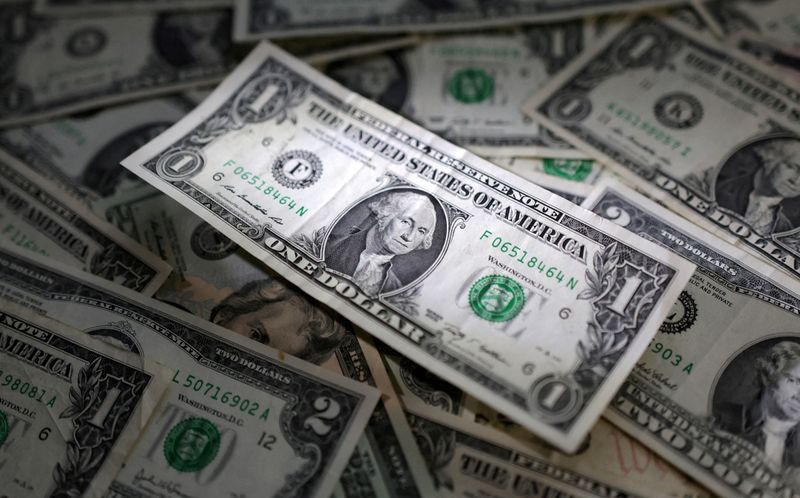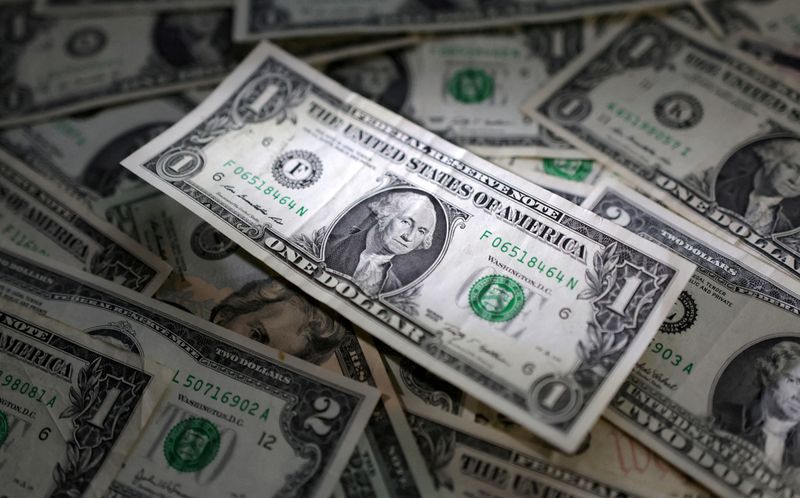Forex
US dollar rises, in consolidation mode, ahead of inflation data


© Reuters. FILE PHOTO: U.S. dollar banknotes are seen in this illustration taken March 10, 2023. REUTERS/Dado Ruvic/Illustration/File Photo
By Gertrude Chavez-Dreyfuss and Herbert Lash
NEW YORK (Reuters) -The dollar rose modestly against major currencies on Monday, as investors braced for data on U.S. inflation and retail sales this week for clues on when the Federal Reserve may begin widely anticipated interest rate cuts.
In cryptocurrencies, bitcoin hit $50,000 for the first time since December 2021, boosted by inflows into exchange traded funds backed by the digital asset. It was last up 5.6% at $50,207.
The , a measure of the greenback against six of its peers, was up 0.1% at 104.12, as the market expects the consumer price index (CPI) for January – due to be released on Tuesday – to give the Fed further confidence that inflation is slowing towards its 2% target.
Wall Street economists expect the year-on-year CPI to rise 2.9%, down from 3.4% in the previous month, according to a Reuters poll. The core CPI is also expected to have slowed its growth on a year-on-year basis in January to 3.7%, from 3.9% in the prior period.
“Psychologically, dropping down into the 2s (in the CPI year-on-year) even though it is 2.9% for the headline CPI number would be a good boost for market sentiment,” said Amo Sahota, executive director at FX consulting firm Klarity FX in San Francisco.
“We’re in a holding pattern here. There seems to be no directional trades. It’s really like: Let’s just take a breath before tomorrow’s (CPI) data, before we make the next push in either direction.”
Ahead of the CPI report on Tuesday, the Federal Reserve Bank of New York released on Monday its January Survey of Consumer Expectations, which showed inflation a year and five years from now were unchanged at readings of 3% and 2.5%, respectively, while the projected rise in inflation three years from now dropped to 2.4%, the lowest since March 2020, from December’s 2.6%.
“The market is in a reasonably good mood going into Tuesday, hoping that we’re going to get a similar outcome,” said Klarity FX’s Sahota.
Retail sales for January are due out on Thursday, with economists expecting a 0.1% decline for January, from a 0.6% rise in December, a Reuters poll showed.
The euro slipped 0.1% against the dollar to $1.0771, falling from a 10-day high touched in early trading. A reading of the euro zone’s economic growth in the fourth quarter on Wednesday could provide fresh direction.
“While it won’t necessarily impact CPI dramatically this month, the most recent round of PMI (purchasing managers index) surveys showed prices increasing for 58.5% of respondents across the two surveys, suggesting inflation could well tick up as we move into spring,” Matthew Weller, global head of research, FOREX.com and City Index, wrote in a research note.
“This is no doubt a concern for the Fed, and may lead to a smaller-than-expected reaction even if this week’s (lagging) CPI reading comes in below expectations,” Weller added.
Changing expectations of when and how quickly central banks will cut interest rates as inflation falls are a significant driver of currency markets at present.
Strong jobs data this month has largely taken a Fed rate cut in March off the table, with markets seeing a move in May as somewhat more likely.
Elsewhere, there is plenty of data due this week in Britain, including inflation and gross domestic product (GDP) numbers with the former, on Wednesday, similarly likely to influence opinion on when the Bank of England will start to cut interest rates. It is currently seen lagging the Fed and ECB.
Sterling was last trading at $1.2628, little changed on the day.
Markets are also keeping an eye on the highly rate-sensitive yen, which strengthened sharply late last year as markets priced in early U.S. rate cuts, but has since weakened as that timing got pushed back.
Japanese authorities intervened in late 2022 to prop up the yen, which weakened to as much as 151.94 per dollar. The dollar was last flat against the yen at 149.31.

 Forex3 years ago
Forex3 years agoForex Today: the dollar is gaining strength amid gloomy sentiment at the start of the Fed’s week

 Forex3 years ago
Forex3 years agoUnbiased review of Pocket Option broker

 Forex3 years ago
Forex3 years agoDollar to pound sterling exchange rate today: Pound plummeted to its lowest since 1985

 Forex3 years ago
Forex3 years agoHow is the Australian dollar doing today?

 Cryptocurrency3 years ago
Cryptocurrency3 years agoWhat happened in the crypto market – current events today

 World3 years ago
World3 years agoWhy are modern video games an art form?

 Commodities3 years ago
Commodities3 years agoCopper continues to fall in price on expectations of lower demand in China

 Economy3 years ago
Economy3 years agoCrude oil tankers double in price due to EU anti-Russian sanctions

























